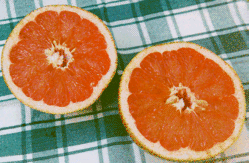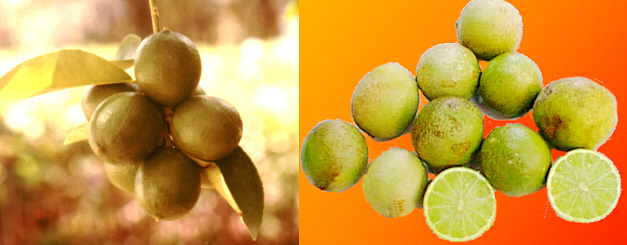
A pink grapefruit for breakfast anyone?
| Component | Flavour threshold ppm |
Amount in fresh orange juice, ppm |
FEMA code |
|---|---|---|---|
| Terpene hydrocarbons | |||
| R(+)-limonene | 0.21 | 1-80 | (2633) |
| myrcene | 0.042 | 0.05-2 | (2762) |
| α-pinene | 1 | 0.02-0.09 | (2902) |
| valencene | - | 0.04-0.2 | |
| Aldehydes | |||
| acetaldehyde | 0.022 | 3-7 | (2003) |
| (E)-2-pentenal | 0.15 | <0.01 | (3218) |
| n-octanal | 0.0005 | <0.01-0.3 | (2797) |
| nonanal | 0.0043 | <0.01-0.04 | (2782) |
| (cis)-4-decanal | 0.0032 | 0.01-0.15 | (3264) |
| citral-a or geranial, citral-b or neral | 0.041 | 0.05-0.3 | (3203) |
| β-sinensal, α-sinensal | 0.0038 | - | |
| Esters | |||
| ethyl acetate | 3.0 | 0.4 | (2414) |
| ethyl propionate | 0.005 | 0.1 | (2456) |
| methyl butanoate | 0.059 | 0.1 | |
| ethyl butanoate | 0.00013 | 0.08-1.4 | |
| ethyl 2-methylbutanoate | 0.0001 | <0.01-0.1 | |
| ethyl 3-hydroxyhexanoate | - | 0.14-1 | (3545) |
| Alcohols | |||
| ethanol | 53 | 380 | |
| (E)-2-hexen-1-ol | - | <0.01 | (2562) |
| (E)-3-hexen-1-ol | 0.07 | <0.01-0.5 | |
| D-linalool | 0.0038 | 0.15-2.34 | (2635) |
| α-terpineol | 0.3 | 0.09-1.1 | (3045) |

| Compound | Concentration (ppm) | Relative Flavour contribution |
|---|---|---|
| limonene | 86 | 376 |
| acetaldehyde | 1.45 | 167 |
| decanal | 0.49 | 100 |
| nootkatone | 6 | 8 |
| ethyl acetate | 16.2 | 1906 |
| methyl butanoate | 4.2 | 278 |
| ethyl butanoate | 10 | 9091 |
| 1-p-menthene-8-thiol | 2.00E-05 | not determined |

| citral-a (geranial) | |
| Compound | oil-juice emulsion (area %) |
distilled oil (area %) |
|---|---|---|
| α-thujene | 0.36 | 0.02 |
| α-pinene | 2.23 | 1.19 |
| sabinene | 3.04 | |
| β-pinene | 19.95 | 2.23 |
| δ-3-carene + 1,4-cineole | 0.02 | 1.96 |
| α-terpinene | 0.17 | 2.53 |
| p-cymene | 0.62 | 1.79 |
| d-limonene + 1,8-cineole | 50.01 | 48.86 |
| g-terpinene + octanol | 7.10 | 10.91 |
| terpinolene + nonanal | 0.41 | 7.76 |
| linalool | 0.15 | 0.05 |
| α-fenchol | 0.66 | |
| terpinen-1-ol | 0.84 | |
| β-terineol | 0.69 | |
| borneol | 0.42 | |
| citronellal | 0.03 | |
| terpinen-4-ol | 0.22 | 0.80 |
| α-terpineol | 0.26 | 6.26 |
| decanal | 0.20 | |
| γ-terpineol (?) | 0.04 | |
| neral | 1.43 | 0.02 |
| geranial | 2.36 | 0.04 |
| undecanal | 0.03 | |
| neryl acetate + unknown | 0.47 | 0.12 |
| geranyl acetate | 0.28 | 0.08 |
| dodecanal | 0.11 |
 Return to Chemistry, UWI-Mona,
Home Page
Return to Chemistry, UWI-Mona,
Home Page
Copyright © 1995-2014 by Robert John Lancashire, all rights reserved.
Created and maintained by Prof. Robert J. Lancashire,